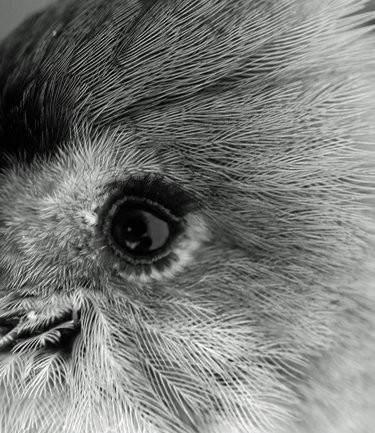Unseen features of feathers, from roots to colors
Fall migration bird banding at the Albany Pine Bush Preserve wrapped up at the end of October. On one of the final mornings of the survey, I went out with the Albany Pine Bush Preserve Commission science staff and volunteers to take some photographs.
It is always interesting to see birds up-close and observe experienced banders extract information like species identity, age, sex, and health through careful examination of the birds. Later, while sorting through my photographs, I paused on a close-up of branching feathers around the eye of a tufted titmouse.
These lacy, dendritic feathers were loose and airy, but not in a way that looked particularly warm or aerodynamic, so I puzzled for a moment over their specific forms. I started to wonder about the structure and function of feathers in general, and a little online research quickly provided me with an abundance of fascinating features hidden in the drabbest of plumage.
I want to share some of the things that surprised me most, and what better place to start than at the root? While the roots of most feathers on the bodies of birds go only as deep as the skin, some feathers are attached to the bird’s skeleton. Yes, those long wing feathers that are critical to a bird’s flight anchor directly to birds’ wing bones with ligaments.
I have generally thought of feathers as being akin to hair. They grow out of specific follicles in the skin, they fall out and are replaced, and they are even made of keratin. But imagine having thick, rigid hairs attached to your bones!
Of course, it makes a lot of sense for these particular feathers to be attached to bone rather than just to skin or muscle, because birds use them to push themselves through air. If these feathers were not held rigidly in place, flying would require much more energy.
Imagine, for instance, trying to row a boat with an oar attached to your shirt rather than one you could hold firmly in your hand. This is roughly analogous to the difference between flying with feathers attached to skin and those attached to bone.
Now, on to color. Look around you. In most environments, the colors we see are the result of pigments absorbing certain wavelengths of light. The light that doesn’t get absorbed by a pigment reflects off of it — this reflected light is what we see as color.
The particular color of the reflected light depends on which wavelengths are present and which are missing. Your blue shirt only looks blue because the dye used to color the shirt is absorbing all the wavelengths of visible light except those that appear blue to us.
A different kind of coloration is at work in many bird feathers. When we see blue, green, or iridescent coloration on a bird, it is usually a result of structural color, sometimes working in conjunction with pigments.
Structural color happens when a material’s microscopic structure sorts white light into light of different wavelengths (colors) and only reflects some of those wavelengths back, allowing the other wavelengths to pass through, scatter, or cancel out due to destructive interference (it’s physics!).
If you’ve ever seen small rainbows of light cast around a room by a glass prism in a window, you’ve observed light being sorted into its different wavelengths by a colorless material (the prism). For another example of structural color, think of the colorful swirls on the surface of soap bubbles. The colors do not come from a pigment in the soap, but from the way the material reflects light.
Structural color can be destroyed by crushing the material, scratching it, or sometimes merely by making it wet. Blue, green, and iridescent bird feathers are fascinating examples of materials that exhibit structural color. Although we cannot see the microscopic structures that create these colors, we can certainly enjoy their effects.
Feather coloration gets even more mysterious, because some of the wavelengths of light that birds see are invisible to us. Most daytime-flying birds can see ultraviolet light, which our eyes cannot detect.
In extreme cases, this means some of those drab birds that seem to all look the same, “little brown jobs” as I’ve heard them described, actually have display coloration visible to each other but not to us. Some of the dyes and detergents used in manufactured objects are also UV reflective, which means we have very little idea of how the manmade environment looks to a bird.
Finally, one last hidden feature of feathers is that the color of a feather often corresponds to the feather’s strength. Melanins are pigments that result in black, red, brown, and pale yellow colors. However, melanins also tend to make feathers stronger.
This is why flight feathers, those same feathers that attach to bones, are often full of melanins and therefore dark in color. White feathers, or white details on dark feathers, do not have much melanin in them and tend to degrade and disintegrate faster.
There is much more to learn and share about feathers, from their growth and evolution to their structure and function. I encourage you to do a little investigating of your own. I found most of the information presented in this article on the Cornell Lab of Ornithology website and through conversations with my knowledgeable colleagues.
Feathers can be extremely interesting objects to encounter on a hike, but please be aware that the Migratory Bird Treaty Act of 1918 makes collecting them illegal in most cases, so best to pack a camera, gloves, and a magnifying lens, and leave feathers where you find them to be enjoyed by others or used by wildlife.
